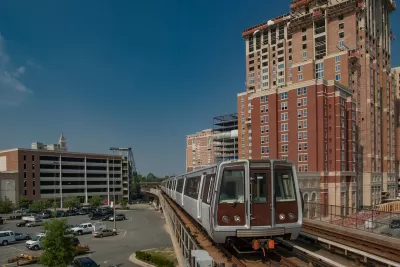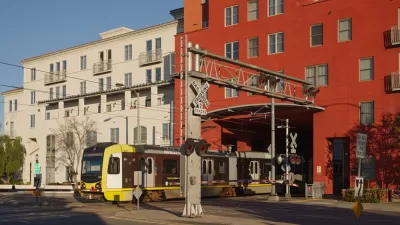Tying housing and land acquisition funding to transit projects could make dense, walkable development easier and more cost-effective.

Federal funding for transit-oriented development (TOD) is often siloed into its separate transportation and housing elements, making it more difficult to build developments that ostensibly combine transportation and housing to create more walkable and affordable communities.
As Kalena Thomhave explains in Smart Cities Dive, this is a problem because transit agencies often don’t own enough land to make development near stations possible. An analysis from the Urban Institute found that “housing is much more likely to be built far from transit, where land and housing costs are lower. Between 2000 and 2019, more than eight times as many housing units were built far from transit than nearby, according to the analysis.”
Cities can promote the integration of housing and transportation by creating a “dedicated land acquisition program” that would be tasked with identifying land acquisition opportunities near transit stations and tie funding for housing programs to transportation projects. In Seattle, Sound Transit has completed several TOD projects that pair new housing with light rail lines.
FULL STORY: How to ease the path to transit-oriented housing development

Planetizen Federal Action Tracker
A weekly monitor of how Trump’s orders and actions are impacting planners and planning in America.

Congressman Proposes Bill to Rename DC Metro “Trump Train”
The Make Autorail Great Again Act would withhold federal funding to the system until the Washington Metropolitan Area Transit Authority (WMATA), rebrands as the Washington Metropolitan Authority for Greater Access (WMAGA).

The Simple Legislative Tool Transforming Vacant Downtowns
In California, Michigan and Georgia, an easy win is bringing dollars — and delight — back to city centers.

The States Losing Rural Delivery Rooms at an Alarming Pace
In some states, as few as 9% of rural hospitals still deliver babies. As a result, rising pre-term births, no adequate pre-term care and harrowing close calls are a growing reality.

The Small South Asian Republic Going all in on EVs
Thanks to one simple policy change less than five years ago, 65% of new cars in this Himalayan country are now electric.

DC Backpedals on Bike Lane Protection, Swaps Barriers for Paint
Citing aesthetic concerns, the city is removing the concrete barriers and flexposts that once separated Arizona Avenue cyclists from motor vehicles.
Urban Design for Planners 1: Software Tools
This six-course series explores essential urban design concepts using open source software and equips planners with the tools they need to participate fully in the urban design process.
Planning for Universal Design
Learn the tools for implementing Universal Design in planning regulations.
Smith Gee Studio
City of Charlotte
City of Camden Redevelopment Agency
City of Astoria
Transportation Research & Education Center (TREC) at Portland State University
US High Speed Rail Association
City of Camden Redevelopment Agency
Municipality of Princeton (NJ)





























